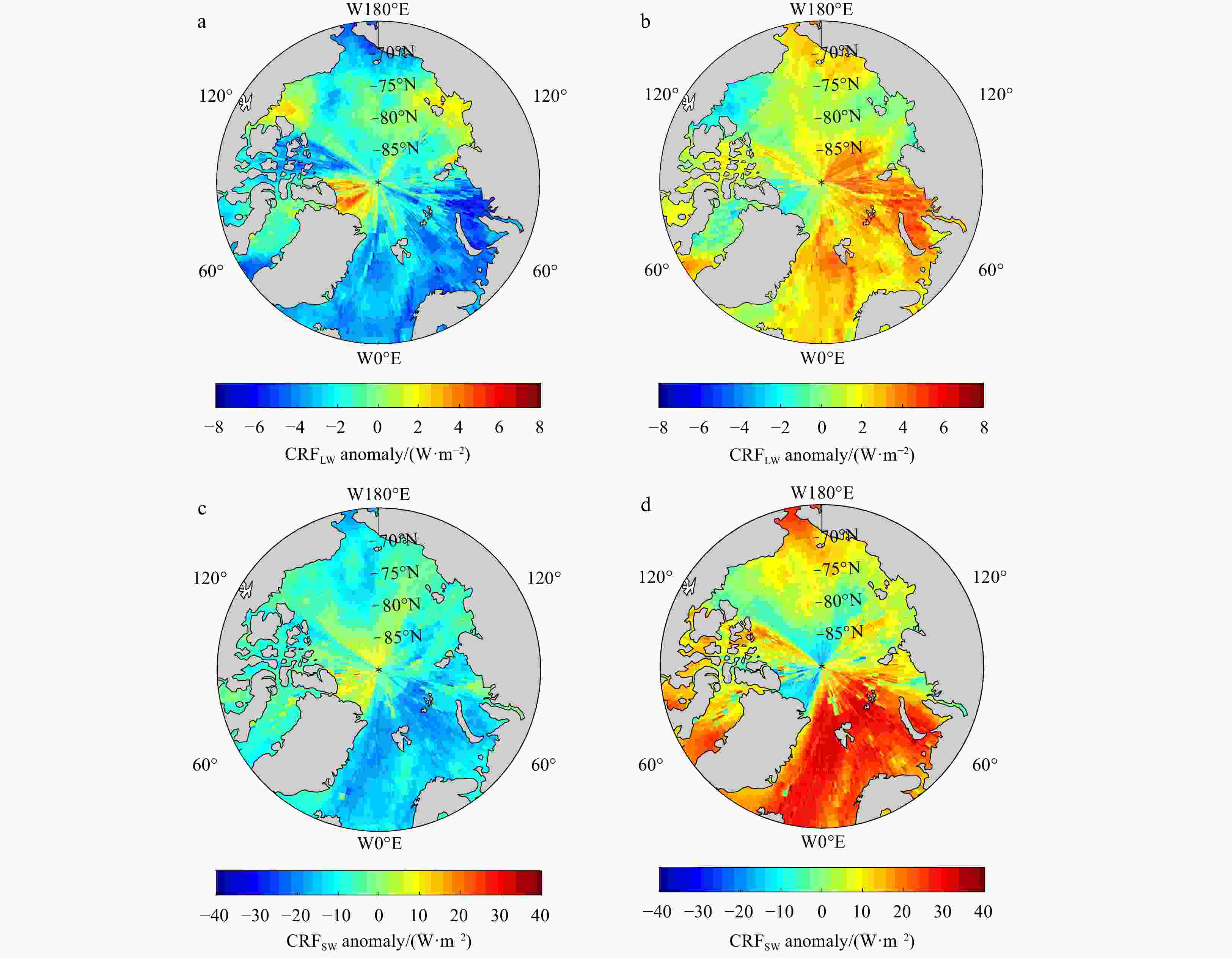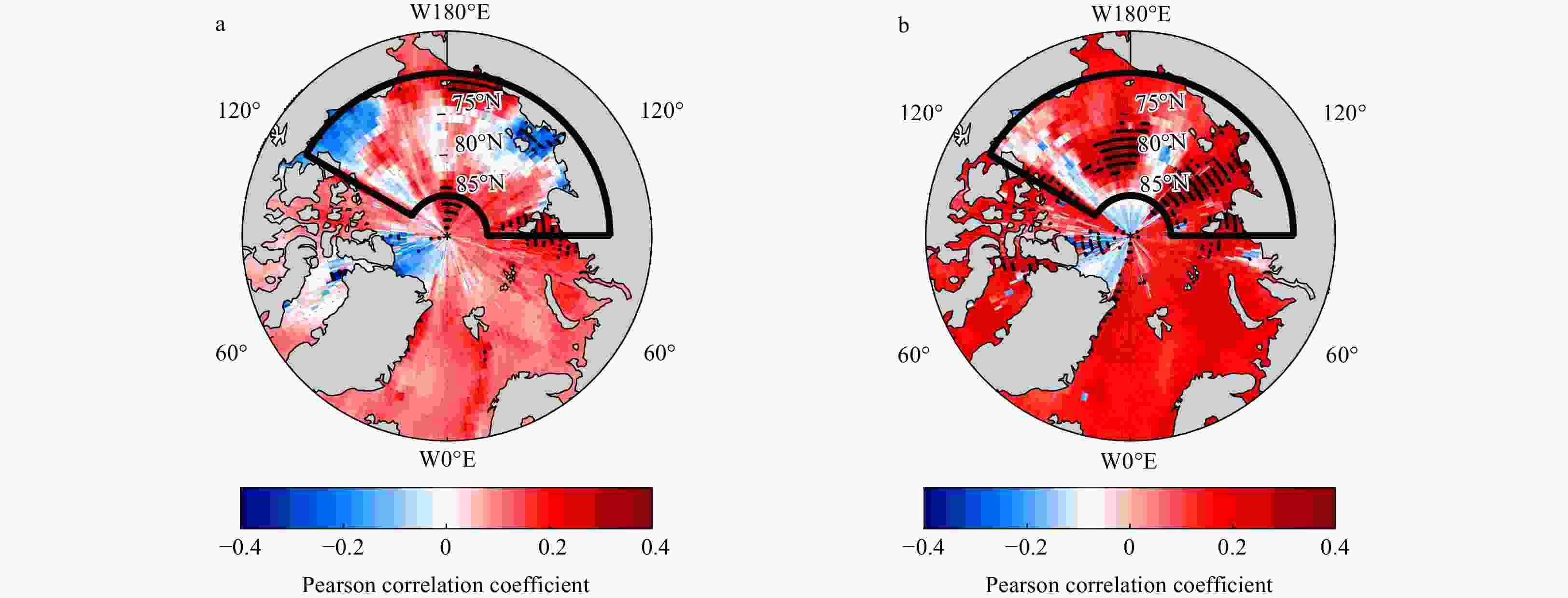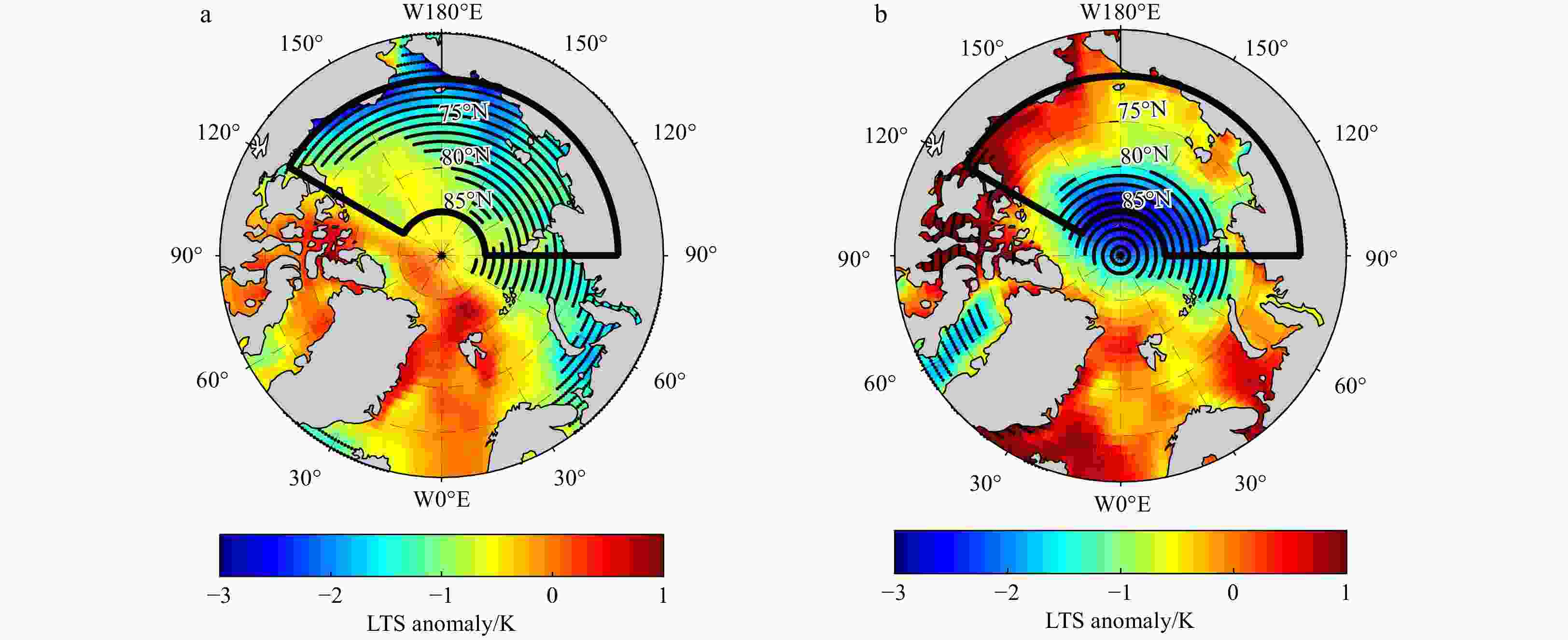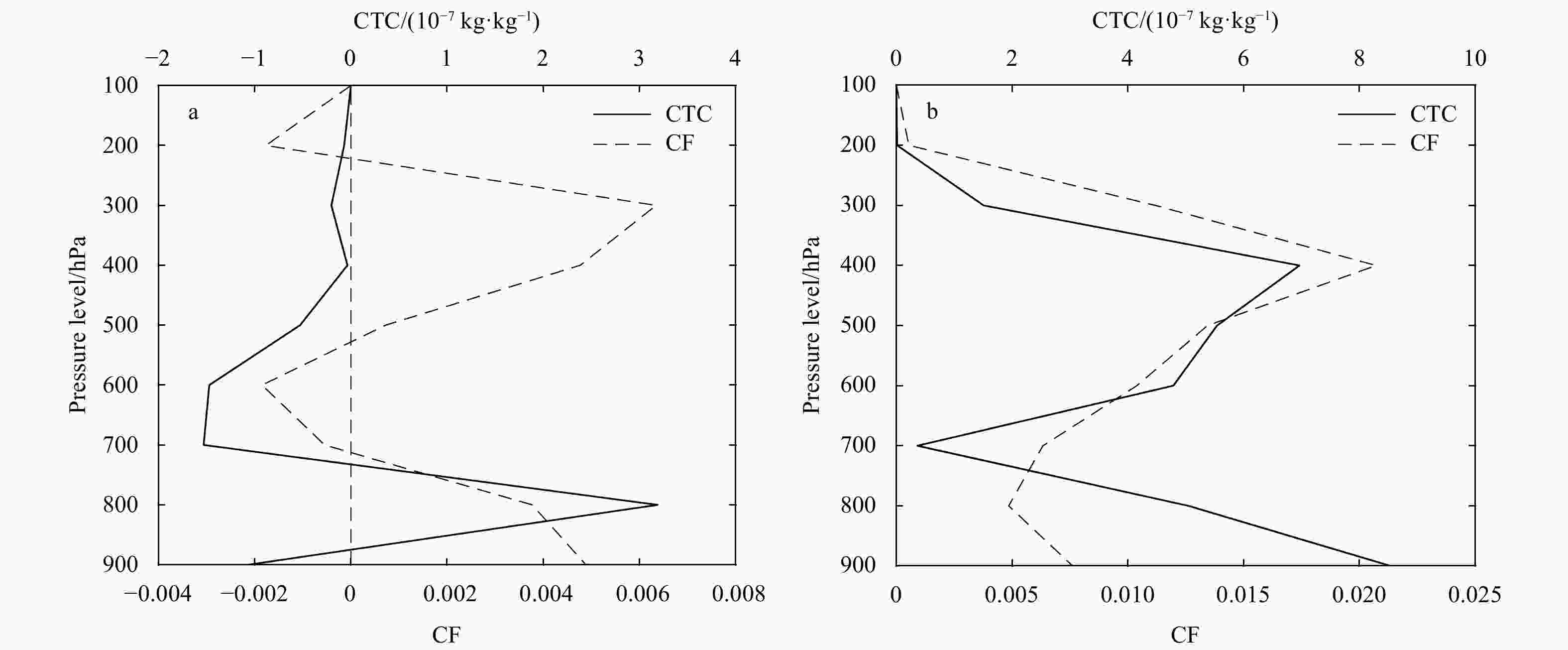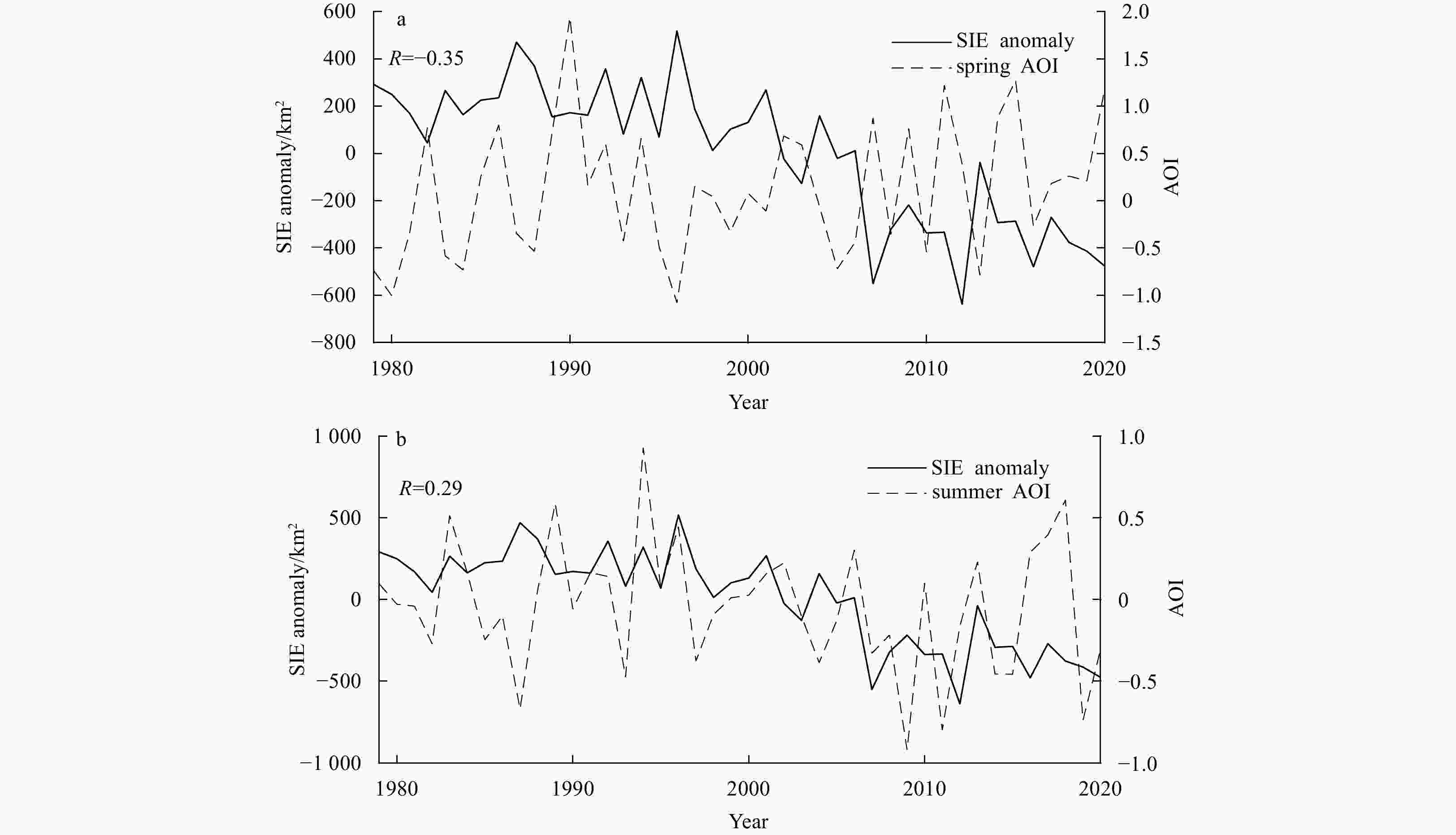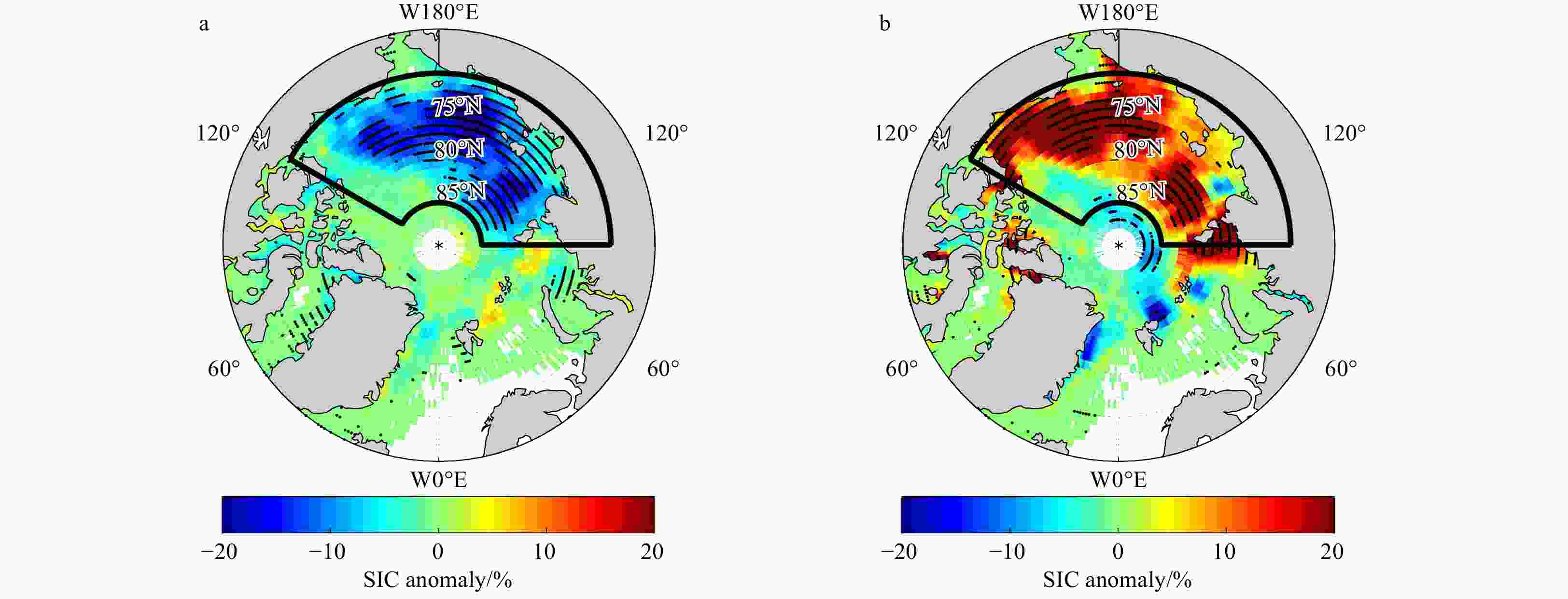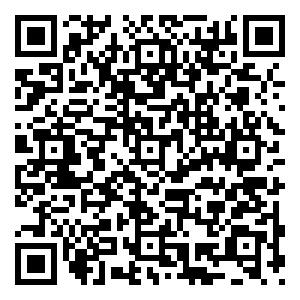Impact of Arctic Oscillation on cloud radiative forcing and September sea ice retreat
-
Abstract: The Arctic Oscillation (AO) has important effects on the sea ice change in terms of the dynamic and thermodynamic processes. However, while the dynamic processes of AO have been widely explored, the thermodynamic processes of AO need to be further discussed. In this paper, we use the fifth state-of-the-art reanalysis at European Centre for Medium-Range Weather Forecasts (ERA5) from 1979 to 2020 to investigate the relationship between AO and the surface springtime longwave (LW) cloud radiative forcing (CRF), summertime shortwave (SW) CRF in the Arctic region (65°−90°N). In addition, the contribution of CRF induced by AO to the sea ice change is also discussed. Results indicate that the positive (negative) anomalies of springtime LW CRF and summertime SW CRF are generally detected over the Arctic Ocean during the enhanced positive (negative) AO phase in spring and summer, respectively. Meanwhile, while the LW (SW) CRF generally has a positive correlation with AO index (AOI) in spring (summer) over the entire Arctic Ocean, this correlation is statistically significant over 70°−85°N and 120°W−90°E (i.e., region of interest (ROI)) in both seasons. Moreover, the response of CRF to the atmospheric conditions varies in spring and summer. We also find that the positive springtime (summertime) AOI tends to decrease (increase) the sea ice in September, and this phenomenon is especially prominent over the ROI. The sensitivity study among sea ice extent, CRF and AOI further reveals that decreases (increases) in September sea ice over the ROI are partly attributed to the springtime LW (summertime SW) CRF during the positive AOI. The present study provides a new pattern of AO affecting sea ice change via cloud radiative effects, which might benefit the sea ice forecast improvement.
-
Key words:
- Arctic /
- Arctic Oscillation /
- cloud radiative forcing /
- sea ice retreat
-
Figure 1. Time series of seasonal mean Arctic Oscillation index (AOI) in spring (March, April and May, MAM) (a) and summer (June, July and August, JJA) (b) during 1979−2020. Solid lines in the middle are the mean AOIs, the upper and lower dashed lines denote the standard deviations of AOI during 1979−2020, and black squares and triangles represent the EN and EP phases, respectively.
Figure 2. Springtime and summertime cloud raliative forcing (CRF) anomalies during different AO phases from 1979 to 2020 over the Arctic Ocean. a. Longwave (LW) CRF anomalies in spring during enhance negative (EN); b. LW CRF anomalies in spring during enhance positive (EP) phase; c. shortwave (SW) CRF anomalies in summer during EN; d. SW CRF anomalies in summer during EP.
Figure 3. Pearson correlation coefficient between springtime longware cloud raditive forcing (CRF) anomaly and Aritc Oscillation index (AOI) (a), as well as between summertime shortwove CRF anomaly and AOI (b) from 1979 to 2020 over the Arctic Ocean. The regin of interest is outlined in black lines. Black dots mark the regions where statistical significance at 90% confidence level or greater.
Figure 6. Time series of sea ice extent (SIE) anomalies in September (solid line) and mean Arctic Oscillation index (AOI, dashed line) over the region of interest from 1979 to 2020 in spring (a) and summer (b). R is the correlation coefficient between AOI and SIE anomalies (statistically significant at the 90% level or greater).
Figure 7. Regression of sea ice concentration (SIC) anomalies in September from 1979 to 2020 on the springtime (a) and summertime (b) Aritic Oscillation index, respectively. The region of interest is outlined in black lines. Regions marked by black dots are statistically significant at the 90% level or greater.
Table 1. The regression slopes among SIE, CRF and AOI in spring and summer, respectively
Season ΔSIE:ΔAOI/
km2ΔSIE:ΔCRF/
(km2·(W·m−2)−1)ΔCRF:ΔAOI/
(W·m−2)Spring −148.43 −0.02 1099.72 Summer 217.49 0.01 9693.93 Note: CRF refers to longwave CRF in spring and shortwave CRF in summer. Results marked in bold are statistically significant at the 90% level or greater. Table 2. The standard correlation (standard R), partial correlation after removing the effects of CRF (partial R) between September SIE and AOI
Season Standard R Partial R Spring −0.34 −0.31 Summer 0.29 0.10 Note: Results marked in bold are statistically significant at the 90% level or greater. -
Barton N P, Klein S A, Boyle J S, et al. 2012. Arctic synoptic regimes: Comparing domain-wide Arctic cloud observations with CAM4 and CAM5 during similar dynamics. Journal of Geophysical Research: Atmospheres, 117(D15): D15205 Bi Haibo, Yang Qinghua, Liang Xi, et al. 2019. Contributions of advection and melting processes to the decline in sea ice in the Pacific sector of the Arctic Ocean. The Cryosphere, 13(5): 1423–1439. doi: 10.5194/tc-13-1423-2019 Budikova D. 2009. Role of Arctic sea ice in global atmospheric circulation: A review. Global and Planetary Change, 68(3): 149–163. doi: 10.1016/j.gloplacha.2009.04.001 Cavalieri D J, Parkinson C L, Gloersen P, et al. 1996. Sea Ice Concentrations from Nimbus-7 SMMR and DMSP SSM/I-SSMIS Passive Microwave Data, Version 1. Boulder, CO, USA: NASA National Snow and Ice Data Center Distributed Active Archive Center Chapman W L, Walsh J E. 1993. Recent variations of sea ice and air temperature in high latitudes. Bulletin of the American Meteorological Society, 74(1): 33–48. doi: 10.1175/1520-0477(1993)074<0033:RVOSIA>2.0.CO;2 Choi Y S, Hwang J, Ok J, et al. 2020. Effect of Arctic clouds on the ice-albedo feedback in midsummer. International Journal of Climatology, 40(10): 4707–4714. doi: 10.1002/joc.6469 Choi Y S, Kim B M, Hur S K, et al. 2014. Connecting early summer cloud-controlled sunlight and late summer sea ice in the Arctic. Journal of Geophysical Research:Atmospheres, 119(19): 11087–11099. doi: 10.1002/2014JD022013 Cohen J, Screen J A, Furtado J C, et al. 2014. Recent Arctic amplification and extreme mid-latitude weather. Nature Geoscience, 7(9): 627–637. doi: 10.1038/ngeo2234 Cox C J, Uttal T, Long C N, et al. 2016. The role of springtime Arctic clouds in determining autumn sea ice extent. Journal of Climate, 29(18): 6581–6596. doi: 10.1175/JCLI-D-16-0136.1 Curry J A, Schramm J L, Rossow W B, et al. 1996. Overview of Arctic cloud and radiation characteristics. Journal of Climate, 9(8): 1731–1764. doi: 10.1175/1520-0442(1996)009<1731:OOACAR>2.0.CO;2 Devasthale A, Tjernström M, Caian M, et al. 2012. Influence of the Arctic Oscillation on the vertical distribution of clouds as observed by the A-Train constellation of satellites. Atmospheric Chemistry and Physics, 12(21): 10535–10544. doi: 10.5194/acp-12-10535-2012 Ding Qinghua, Schweiger A, L’Heureux M, et al. 2017. Influence of high-latitude atmospheric circulation changes on summertime Arctic sea ice. Nature Climate Change, 7(4): 289–295. doi: 10.1038/nclimate3241 Dong Xiquan, Xi Baike, Crosby K, et al. 2010. A 10 year climatology of Arctic cloud fraction and radiative forcing at Barrow, Alaska. Journal of Geophysical Research: Atmospheres, 115(D17): D17212. doi: 10.1029/2009JD013489 Eastman R, Warren S G. 2010. Interannual variations of Arctic cloud types in relation to sea ice. Journal of Climate, 23(15): 4216–4232. doi: 10.1175/2010JCLI3492.1 Grebmeier J M, Maslowski W. 2014. The Pacific Arctic Region: Ecosystem Status and Trends in a Rapidly Changing Environment. Dordrecht, Netherlands: Springer Hegyi B M, Taylor P C. 2017. The regional influence of the Arctic Oscillation and Arctic Dipole on the wintertime Arctic surface radiation budget and sea ice growth. Geophysical Research Letters, 44(9): 4341–4350. doi: 10.1002/2017GL073281 Hersbach H, Bell B, Berrisford P, et al. 2020. The ERA5 global reanalysis. Quarterly Journal of the Royal Meteorological Society, 146(730): 1999–2049. doi: 10.1002/qj.3803 Holland M M, Stroeve J. 2011. Changing seasonal sea ice predictor relationships in a changing Arctic climate. Geophysical Research Letters, 38(18): L18501 Huang Yiyi, Dong Xiquan, Bailey D A, et al. 2019. Thicker clouds and accelerated Arctic sea ice decline: The atmosphere-sea ice interactions in spring. Geophysical Research Letters, 46(12): 6980–6989. doi: 10.1029/2019GL082791 Huang Yiyi, Dong Xiquan, Xi Baike, et al. 2017. The footprints of 16 year trends of Arctic springtime cloud and radiation properties on September sea ice retreat. Journal of Geophysical Research: Atmospheres, 122(4): 2179–2193. doi: 10.1002/2016JD026020 Ingram W J, Wilson C A, Mitchell J F B. 1989. Modeling climate change: An assessment of sea ice and surface albedo feedbacks. Journal of Geophysical Research:Atmospheres, 94(D6): 8609–8622. doi: 10.1029/JD094iD06p08609 Kawaguchi Y, Kikuchi T, Inoue R. 2014. Vertical heat transfer based on direct microstructure measurements in the ice-free Pacific-side Arctic Ocean: The role and impact of the Pacific water intrusion. Journal of Oceanography, 70(4): 343–353. doi: 10.1007/s10872-014-0234-8 Kay J E, L’Ecuyer T. 2013. Observational constraints on Arctic Ocean clouds and radiative fluxes during the early 21st century. Journal of Geophysical Research: Atmospheres, 118(13): 7219–7236. doi: 10.1002/jgrd.50489 Kay J E, L’Ecuyer T, Gettelman A, et al. 2008. The contribution of cloud and radiation anomalies to the 2007 Arctic sea ice extent minimum. Geophysical Research Letters, 35(8): L08503 Klein S A, Hartmann D L. 1993. The seasonal cycle of low stratiform clouds. Journal of Climate, 6(8): 1587–1606. doi: 10.1175/1520-0442(1993)006<1587:TSCOLS>2.0.CO;2 Kwok R. 2018. Arctic sea ice thickness, volume, and multiyear ice coverage: losses and coupled variability (1958–2018). Environmental Research Letters, 13(10): 105005. doi: 10.1088/1748-9326/aae3ec Li Ying, Thompson D W J, Huang Yi, et al. 2014a. Observed linkages between the northern annular mode/North Atlantic Oscillation, cloud incidence, and cloud radiative forcing. Geophysical Research Letters, 41(5): 1681–1688. doi: 10.1002/2013GL059113 Li Ying, Thompson D W J, Stephens G L, et al. 2014b. A global survey of the instantaneous linkages between cloud vertical structure and large-scale climate. Journal of Geophysical Research: Atmospheres, 119(7): 3770–3792. doi: 10.1002/2013JD020669 Liang Yu, Bi Haibo, Wang Yunhe, et al. 2020. Role of atmospheric factors in forcing Arctic sea ice variability. Acta Oceanologica Sinica, 39(9): 60–72. doi: 10.1007/s13131-020-1629-6 Liu Jiping, Curry J A, Hu Yongyun. 2004. Recent Arctic sea ice variability: Connections to the Arctic Oscillation and the ENSO. Geophysical Research Letters, 31(9): L09211 Luo Binhe, Luo Dehai, Wu Lixin, et al. 2017. Atmospheric circulation patterns which promote winter Arctic sea ice decline. Environmental Research Letters, 12(5): 054017. doi: 10.1088/1748-9326/aa69d0 Luo Binhe, Wu Lixin, Luo Dehai, et al. 2019. The winter midlatitude-Arctic interaction: Effects of North Atlantic SST and high-latitude blocking on Arctic sea ice and Eurasian cooling. Climate Dynamics, 52(5/6): 2981–3004. doi: 10.1007/s00382-018-4301-5 Lynch A H, Serreze M C, Cassano E N, et al. 2016. Linkages between Arctic summer circulation regimes and regional sea ice anomalies. Journal of Geophysical Research: Atmospheres, 121(13): 7868–7880. doi: 10.1002/2016JD025164 Maslanik J, Drobot S, Fowler C, et al. 2007. On the Arctic climate paradox and the continuing role of atmospheric circulation in affecting sea ice conditions. Geophysical Research Letters, 34(3): L03711 Meredith M, Sommerkorn M, Cassotta S, et al. 2019. Polar Regions. Chapter 3, IPCC Special Report on the Ocean and Cryosphere in a Changing Climate. https://repository.library.noaa.gov/view/noaa/27411/noaa_27411_DS1.pdf [2019-12-30/2021-10-01] Ogi M, Rysgaard S, Barber D G. 2016. Importance of combined winter and summer Arctic Oscillation (AO) on September sea ice extent. Environmental Research Letters, 11(3): 034019. doi: 10.1088/1748-9326/11/3/034019 Ogi M, Wallace J M. 2012. The role of summer surface wind anomalies in the summer Arctic sea ice extent in 2010 and 2011. Geophysical Research Letters, 39(9): L09704 Ogi M, Yamazaki K. 2010. Trends in the summer northern annular mode and Arctic sea ice. SOLA, 2010(6): 41–44 Olonscheck D, Mauritsen T, Notz D. 2019. Arctic sea-ice variability is primarily driven by atmospheric temperature fluctuations. Nature Geoscience, 12(6): 430–434. doi: 10.1038/s41561-019-0363-1 Overland J E, Wang Muyin. 2010. Large-scale atmospheric circulation changes are associated with the recent loss of Arctic sea ice. Tellus A: Dynamic Meteorology and Oceanography, 62(1): 1–9. doi: 10.1111/j.1600-0870.2009.00421.x Perlwitz J, Graf H F. 1995. The statistical connection between tropospheric and stratospheric circulation of the Northern Hemisphere in winter. Journal of Climate, 8(10): 2281–2295. doi: 10.1175/1520-0442(1995)008<2281:TSCBTA>2.0.CO;2 Philipp D, Stengel M, Ahrens B. 2020. Analyzing the Arctic feedback mechanism between sea ice and low-level clouds using 34 years of satellite observations. Journal of Climate, 33(17): 7479–7501. doi: 10.1175/JCLI-D-19-0895.1 Ramanathan V, Cess R D, Harrison E F, et al. 1989. Cloud-radiative forcing and climate: Results from the earth radiation budget experiment. Science, 243(4887): 57–63. doi: 10.1126/science.243.4887.57 Rigor I G, Wallace J M. 2004. Variations in the age of Arctic sea-ice and summer sea-ice extent. Geophysical Research Letters, 31(9): L09401 Rigor I G, Wallace J M, Colony R L. 2002. Response of sea ice to the Arctic Oscillation. Journal of Climate, 15(18): 2648–2663. doi: 10.1175/1520-0442(2002)015<2648:ROSITT>2.0.CO;2 Rudeva I, Simmonds I. 2021. Midlatitude winter extreme temperature events and connections with anomalies in the arctic and tropics. Journal of Climate, 34(10): 3733–3749. doi: 10.1175/JCLI-D-20-0371.1 Screen J A, Bracegirdle T J, Simmonds I. 2018. Polar climate change as manifest in atmospheric circulation. Current Climate Change Reports, 4(4): 383–395. doi: 10.1007/s40641-018-0111-4 Screen J A, Deser C, Simmonds I, et al. 2014. Atmospheric impacts of Arctic sea-ice loss, 1979–2009: Separating forced change from atmospheric internal variability. Climate Dynamics, 43(1/2): 333–344. doi: 10.1007/s00382-013-1830-9 Sedlar J, Devasthale A. 2012. Clear-sky thermodynamic and radiative anomalies over a sea ice sensitive region of the Arctic. Journal of Geophysical Research: Atmospheres, 117(D19): D19111 Sedlar J, Tjernström M, Mauritsen T, et al. 2011. A transitioning Arctic surface energy budget: the impacts of solar zenith angle, surface albedo and cloud radiative forcing. Climate Dynamics, 37(7/8): 1643–1660. doi: 10.1007/s00382-010-0937-5 Shupe M D, Intrieri J M. 2004. Cloud radiative forcing of the Arctic surface: The influence of cloud properties, surface albedo, and solar zenith angle. Journal of Climate, 17(3): 616–628. doi: 10.1175/1520-0442(2004)017<0616:CRFOTA>2.0.CO;2 Simmonds I, Li Muyuan. 2021. Trends and variability in polar sea ice, global atmospheric circulations, and baroclinicity. Annals of the New York Academy of Sciences, 1504(1): 167–186. doi: 10.1111/nyas.14673 Smith K L, Polvani L M, Tremblay L B. 2018. The impact of stratospheric circulation extremes on minimum Arctic sea ice extent. Journal of Climate, 31(18): 7169–7183. doi: 10.1175/JCLI-D-17-0495.1 Thompson D W J, Wallace J M. 1998. The Arctic oscillation signature in the wintertime geopotential height and temperature fields. Geophysical Research Letters, 25(9): 1297–1300. doi: 10.1029/98GL00950 Thompson D W J, Wallace J M. 2000. Annular modes in the extratropical circulation. Part I: Month-to-month variability. Journal of Climate, 13(5): 1000–1016. doi: 10.1175/1520-0442(2000)013<1000:AMITEC>2.0.CO;2 Vavrus S. 2004. The impact of cloud feedbacks on Arctic climate under greenhouse forcing. Journal of Climate, 17(3): 603–615. doi: 10.1175/1520-0442(2004)017<0603:TIOCFO>2.0.CO;2 Vavrus S, Holland M M, Bailey D A. 2011. Changes in Arctic clouds during intervals of rapid sea ice loss. Climate Dynamics, 36(7/8): 1475–1489. doi: 10.1007/s00382-010-0816-0 Walsh J E, Johnson C M. 1979. Interannual atmospheric variability and associated fluctuations in Arctic sea ice extent. Journal of Geophysical Research: Oceans, 84(C11): 6915–6928. doi: 10.1029/JC084iC11p06915 Wang Jia, Ikeda M. 2000. Arctic oscillation and Arctic sea-ice oscillation. Geophysical Research Letters, 27(9): 1287–1290. doi: 10.1029/1999GL002389 Wang Xuanji, Key J R. 2003. Recent trends in Arctic surface, cloud, and radiation properties from space. Science, 299(5613): 1725–1728. doi: 10.1126/science.1078065 Wang Xuanji, Key J R. 2005. Arctic surface, cloud, and radiation properties based on the AVHRR Polar Pathfinder dataset. Part I: Spatial and temporal characteristics. Journal of Climate, 18(14): 2558–2574. doi: 10.1175/JCLI3438.1 Wang Wenshan, Zender C S, van As D, et al. 2019. Spatial distribution of melt season cloud radiative effects over Greenland: Evaluating satellite observations, reanalyses, and model simulations against in situ measurements. Journal of Geophysical Research: Atmospheres, 124(1): 57–71. doi: 10.1029/2018JD028919 Wang Jia, Zhang Jinlun, Watanabe E, et al. 2009. Is the dipole anomaly a major driver to record lows in Arctic summer sea ice extent?. Geophysical Research Letters, 36(5): L05706 Watanabe E, Wang Jia, Sumi A, et al. 2006. Arctic dipole anomaly and its contribution to sea ice export from the Arctic Ocean in the 20th century. Geophysical Research Letters, 33(23): L23703. doi: 10.1029/2006GL028112 Wu Bingyi, Wang Jia. 2002. Possible impacts of winter Arctic Oscillation on Siberian high, the East Asian winter monsoon and sea-ice extent. Advances in Atmospheric Sciences, 19(2): 297–320. doi: 10.1007/s00376-002-0024-x Wu Bingyi, Wang Jia, Walsh J E. 2006. Dipole anomaly in the winter Arctic atmosphere and its association with sea ice motion. Journal of Climate, 19(2): 210–225. doi: 10.1175/JCLI3619.1 Zhang Rong. 2015. Mechanisms for low-frequency variability of summer Arctic sea ice extent. Proceedings of the National Academy of Sciences of the United States of America, 112(15): 4570–4575. doi: 10.1073/pnas.1422296112 Zhang T, Bowling S A, Stamnes K. 1997. Impact of the atmosphere on surface radiative fluxes and snowmelt in the Arctic and Subarctic. Journal of Geophysical Research: Atmospheres, 102(D4): 4287–4302. doi: 10.1029/96JD02548 Zhang Shuyu, Gan T Y, Bush A B G. 2020. Variability of arctic sea ice based on quantile regression and the teleconnection with large-scale climate patterns. Journal of Climate, 33(10): 4009–4025. doi: 10.1175/JCLI-D-19-0375.1 Zhang Xiangdong, Ikeda M, Walsh J E. 2003. Arctic sea ice and freshwater changes driven by the atmospheric leading mode in a coupled sea ice-ocean model. Journal of Climate, 16(13): 2159–2177. doi: 10.1175/2758.1 Zhao Jinping, Cao Yong, Shi Jiuxin. 2006. Core region of Arctic Oscillation and the main atmospheric events impact on the Arctic. Geophysical Research Letters, 33(22): L22708. doi: 10.1029/2006GL027590 -





 下载:
下载:
